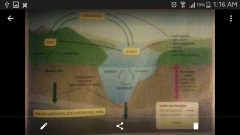![]()
![]()
![]()
Use LEFT and RIGHT arrow keys to navigate between flashcards;
Use UP and DOWN arrow keys to flip the card;
H to show hint;
A reads text to speech;
33 Cards in this Set
- Front
- Back
|
Atmosphere |
Layer of gases surrounding a planet or moon |
|
|
Climate |
Prevailing weather conditions over a long time period in an area |
|
|
Weather |
The state of the atmosphere at a certain time and place |
|
|
Closed and Open System |
Closed: does not let energy in; isolated Open: lets in or through in |
|
|
Anthropogenic |
Something caused or made by humans |
|
|
Latitude |
North to South |
|
|
Seasons |
A certain period in the year noted because of its particular weather conditions/temperature |
|
|
Nitrogen Cycle |
Atmosphere -> Factory -> Fertilizer -> Gas. Atmosphere -> Factory -> Sewage -> Water. Transportation + Industries -> Atmosphere. |
|
|
Carbon Cycle |
Atmosphere -> Oceans/Organic matter. Oceans -> Sediments/Sedimentary rock -> Fossil Fuels -> Atmosphere. Oceans -> Fossil Fuels -> Atmosphere. Oceans -> Atmosphere. |
|
|
Earth's Climate System |

Set up of components interacting together to produce Earth's climate, powered by the Sun. Includes air, land, liquid water, ice, and living things. |
|
|
Effects on Climate |
Carbon: When CO2 increases, oceans absorb more CO2. Oceans will be more acidic and warm and could accelerate global warming. Nitrogen: Humans increased nitrogen in waters. Causes algal to bloom and results in dead zones in lakes and oceans. |
|
|
Atmosphere and Climate |
The atmosphere determines the climate |
|
|
Wind |
Air in motion moving horizontally at any speed along earth's surface |
|
|
Energy Transfer |
Comes from sun, some absorbed by oceans, some goes into atmosphere and some back into space. |
|
|
Oceans |
Ocean circulation -> Thermohaline circulation. Warm water rises, cold water sinks; makes a warm surface flow. |
|
|
Albedo |
Fraction of incident light/radiation reflected off a surface. |
|
|
World Climate zones |
Temperate: Between Polar and Tropical (Very warm/cold seasons: Canada). Polar: Between North and South pole + Antarctica (Cold and icy). Tropical: Located between equator + Tropic of Cancer (^23.5*) and Tropic of Capricorn (v23.5*)
|
|
|
Biomes in Canada |
Permanent Ice, Tundra, Boreal Forest, Temperate Deciduous Forest, Temperate Rainforest, Grassland, Desert, Prairies. |
|
|
Biome |
Large regions with similar types of plant and animal species under climate of certain area. |
|
|
Ecozone |
Division of earth's surface that's developed over long periods of time by separations from neighbouring zones by oceans, mountain ranges and deserts. |
|
|
Ecoregion |
Subdivision of an ecozone characterized by local landforms |
|
|
Effects of Changing Climate |
Volcanic eruptions, air and ocean currents, and the sun's radiation |
|
|
Indicators of Climate Change |
Melting ice -> Rising sea level and rising ocean acidity. Changing winds and precipitation. Desertification and Droughts. Storm intensity rising. |
|
|
Common greenhouse gases + source |
Water vapour, CO2 (Burning fossil fuels), CH4 (Cattle), O3, N2O (Fertilizers) |
|
|
Types of Energy Transfer |
Conduction (Particle Collision) , Convection (Energy movement in Liquid), Radiation (Waves). |
|
|
Positive and Negative Feedback loop |
Positive: the effect increasing the original cause. Negative: the effect decreases the original cause |
|
|
El Nino and La Nina |
Nino: winds going west weak and may reverse. Warm water in pacific goes eats and prevents warm water from rising. Nina: Winds push warm Pacific waters west to Asia, leaving North America with cooler temperatures. |
|
|
Earth's Energy Budget |
Total energy exchange of Earth's system. How energy from sun enter, goes through, and leaves Earth's system. |
|
|
Climate Change |
Change in global or regional climate patterns |
|
|
Evidence of past climates |
Tree rings, ice cores, sedimentary cores, fossils |
|
|
Satellites |
Geostationary: Satellites orbiting earth at the same speed the earth rotates. Polar Orbiting: Satellites move north + south over poles as earth turns beneath them. |
|
|
Meteorological data |
Meteorological facts that have to do with the atmosphere - any phenomena that affects military operations |
|
|
List of actions to reduce global warming |
Reduce, Reuse, Recycle. Use less heat + AC. Drive smart. Use less hot water. Plant tree. |

